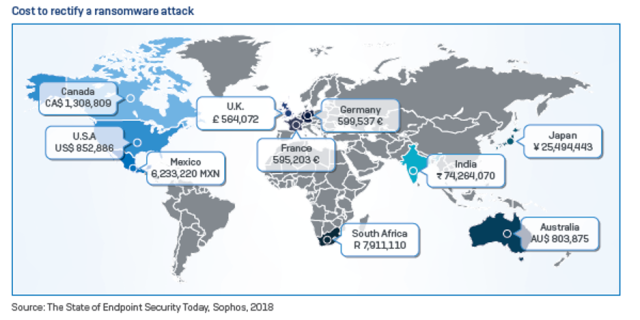It may have been around for 30 years, but ransomware continues to evolve and bring organizations to their knees. Make sure you’re ready for it.
Thirty years on from the world’s first attack, ransomware is stronger than ever. Cybercriminals continue to evolve their tactics and techniques, taking advantage of changes in technology and society to refine their approach.
The result: highly advanced, highly complex threats that can bring organizations to their knees. When you add together the full costs of remediation, including downtime, people time, device cost, network cost, lost opportunities and ransom paid, the final sums per victim are eye-watering.

What’s next for ransomware?
The one thing we can be sure of is that ransomware is going to keep evolving. Here are three new areas where the tentacles of ransomware are starting to reach.
Public cloud ransomware targets and encrypts data stored in public cloud services like Amazon Web Services (AWS), Microsoft Azure (Azure) and Google Cloud Platform (GCP).
While the public cloud offers lots of advantages, confusion about security responsibilities creates gaps in protection that hackers are quick to exploit.
In addition, weak configuration and open public access to cloud resources (be that storage buckets, databases, user accounts, etc.) make it easier for criminals to breach data storage.
Service provider attacks. As technology and threats become ever more complex, companies are increasingly outsourcing their IT to specialist managed service providers (MSPs).
Cybercriminals have realized that targeting MSPs enables them to hold multiple organizations hostage with a single attack. One attack, many ransoms.
MSPs offer a level of security expertise that is hard to match in many organizations. If you use a MSP, make security one of your selection criteria. A good MSP will be happy to share how it secures both its own and its customers’ organizations.
Encryption-free attacks. The ability to encrypt files was one of the original core capabilities needed to make ransomware a viable cybercrime.
Today cybercriminals no longer need to encrypt your files to hold you hostage. Why? Because they believe you’ll pay up just to stop your data going public.
How to defend against ransomware
Adopt a three-pronged approach to minimize your risk of falling victim to an attack.
1. Threat protection that disrupts the whole attack chain.
As we saw recently with Ryuk, today’s ransomware attacks use multiple techniques and tactics, so focusing your defense on a single technology leaves you very vulnerable.
Instead, deploy a range of technologies to disrupt as many stages in the attack as possible. And integrate the public cloud into your security strategy.
2. Strong security practices.
These include:
- Use multi-factor authentication (MFA)
- Use complex passwords, managed through a password manager
- Limit access rights; give user accounts and admins only the access rights they need
- Make regular backups, and keep them offsite and offline where attackers can’t find them
- Patch early, patch often; ransomware like WannaCry relied on unpatched vulnerabilities to spread
- Lock down your RDP; turn it off if you don’t need it, use rate limiting, 2FA or a VPN if you do
- Ensure tamper protection is enabled – Ryuk and other ransomware strains attempt to disable your endpoint protection, and tamper protection is designed to prevent this from happening
3. Ongoing staff education.
People are invariably the weakest link in cybersecurity, and cybercriminals are experts at exploiting normal human behaviors for nefarious gain. Invest – and keep investing – in staff training.
Learn more
Read our new paper Ransomware: The Cyberthreat that Just Won’t Die for a deeper dive into what’s behind ransomware’s longevity, where it’s going, and how best to defend against it.
How Sophos can help
Sophos offers a range of products and services to help you protect against ransomware:
- Sophos Managed Threat Response (MTR). Many organizations don’t have the expertise, resources, or desire to monitor their network 24/7. The Sophos MTR service is a dedicated, round-the-clock team of threat hunters and response experts who constantly scan for and act on suspicious activity.
- Sophos Intercept X includes advanced protection technologies that stop ransomware on your endpoints and servers at multiple stages of the attack chain, including AI-powered threat protection, exploit protection, credential theft, deep learning and CryptoGuard.
- Sophos XG Firewall is packed with advanced protection to detect and block ransomware attacks, and stop hackers moving laterally around your network to escalate privileges.
- Cloud Optix continuously analyzes public cloud resources to detect, respond and prevent gaps in security across AWS, Azure and GCP public cloud environments that can be exploited in a ransomware attack.
- Synchronized Security. Intercept X and XG Firewall are great on their own, but even better together. If anything triggers a detection, XG Firewall and Intercept X work together to automatically isolate the affected devices – preventing the threat from spreading further.





